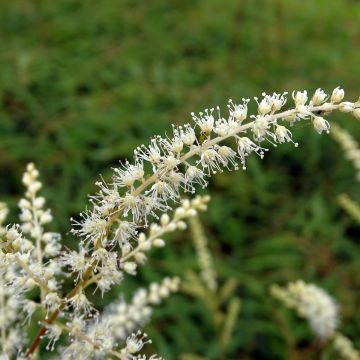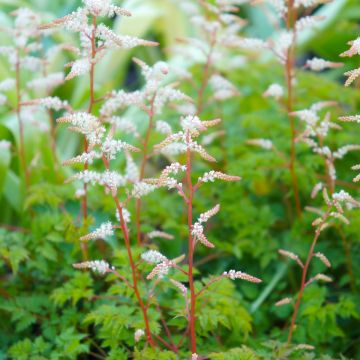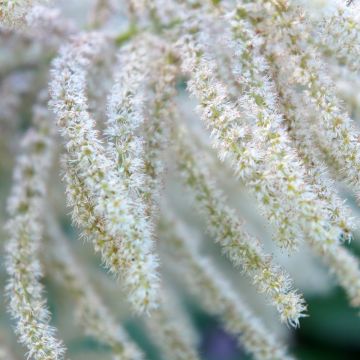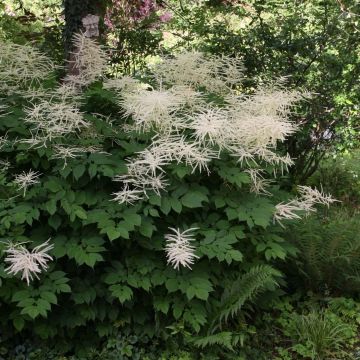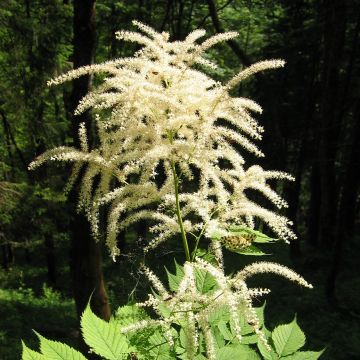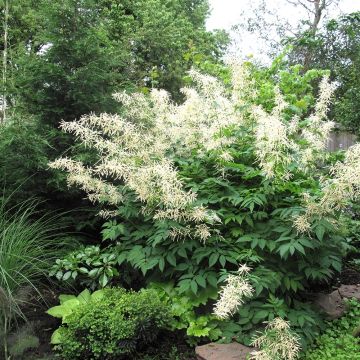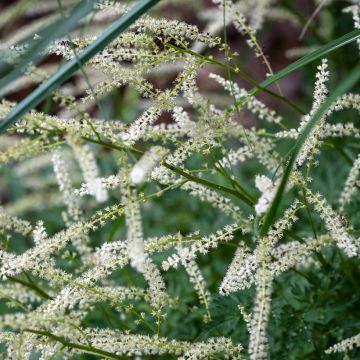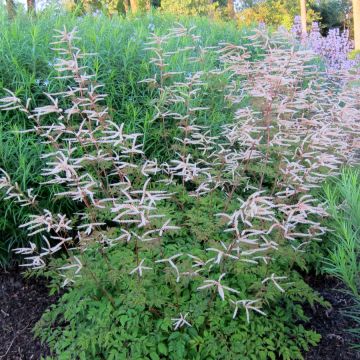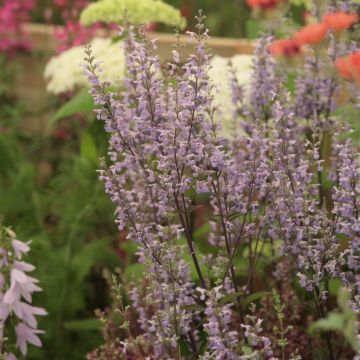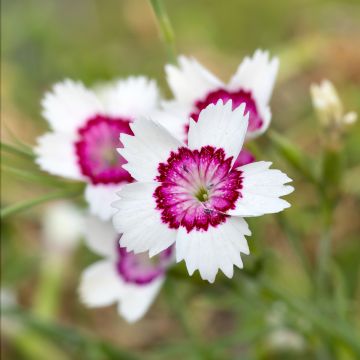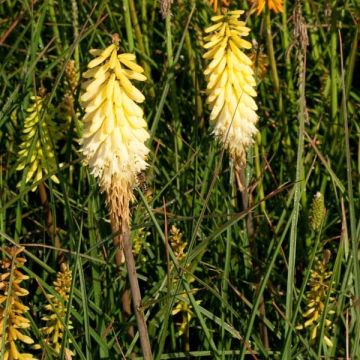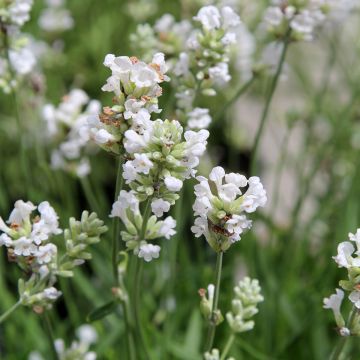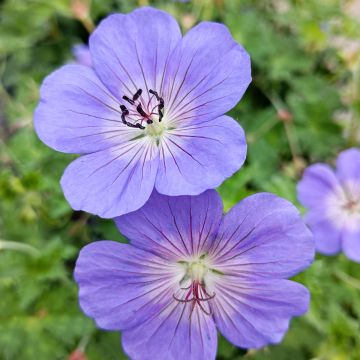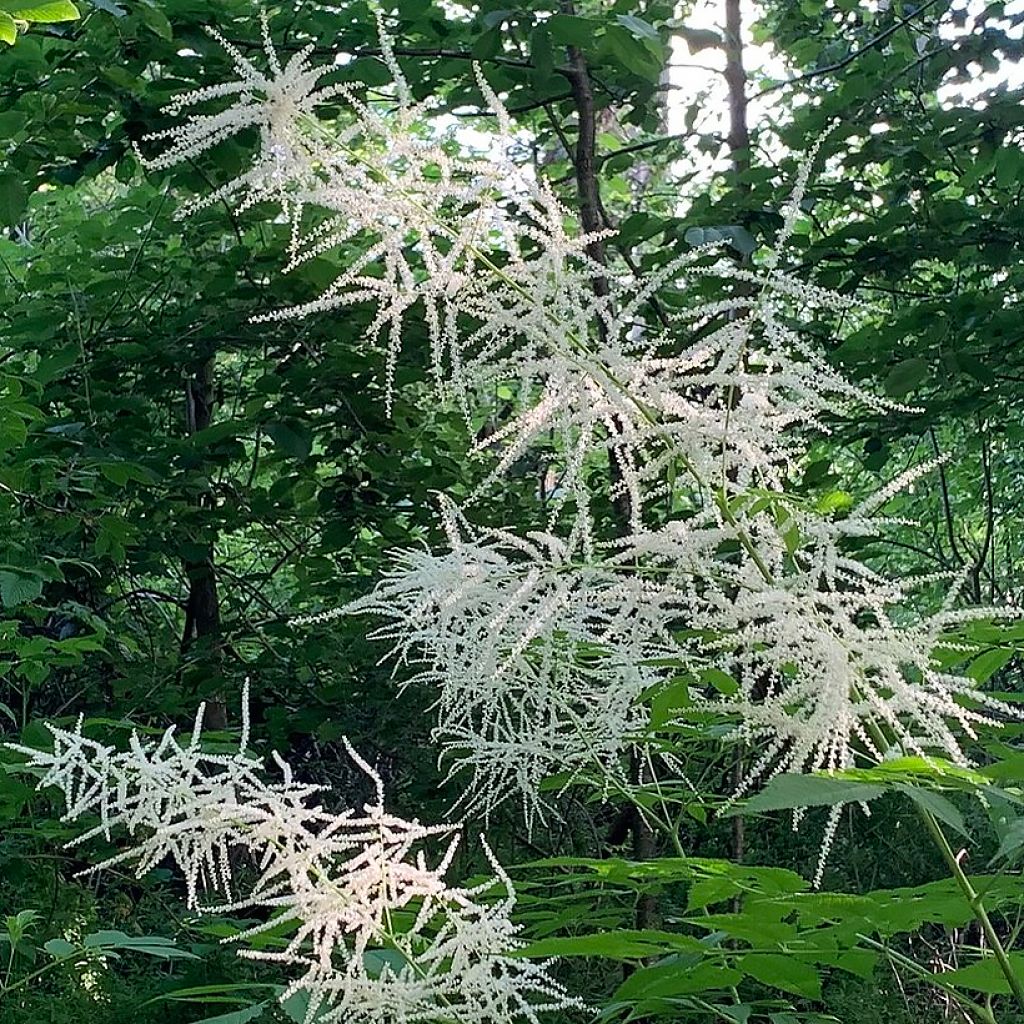

Aruncus Chantilly Lace
Aruncus Chantilly Lace
Aruncus aethusifolius x dioicus Chantilly Lace
Goat's Beard
We are in April and the young plant is slowly starting its growth. It looks to be in good shape. Otherwise, careful packaging and timely shipment.
Antoinette , 02/04/2023
This item cannot be shipped to the selected country
Delivery charge from €5.90
More information
Schedule delivery date,
and select date in basket
This plant carries a 12 months recovery warranty
More information
We guarantee the quality of our plants for a full growing cycle, and will replace at our expense any plant that fails to recover under normal climatic and planting conditions.
From €5.90 for pickup delivery and €6.90 for home delivery
Express home delivery from €8.90.
Does this plant fit my garden?
Set up your Plantfit profile →
Description
The 'Aruncus 'Chantilly Lace' is a hybrid variety of Goat's Beard with a compact and spreading habit. Its summer flowering is airy, with slender and graceful cream-white to cream-yellow panicles carried on purple stems. This cultivar combines the qualities of its two parents: it is of modest size very hardy, and its superb astilbe-like foliage turns to bronze copper in autumn. It is slightly taller than the Aruncus 'Misty Lace' and has wider panicles. It is a beautiful perennial for woodland areas, ideal in shaded areas of gardens, and particularly attractive near water features. This cultivar tolerates hot and humid summers well.
The Goat's Beard 'Chantilly Lace' is a rhizomatous, stoloniferous perennial plant forming a bushy clump from spring onwards. It belongs to the rose family. This hybrid was selected in 2003 by Dr. Allan Armitage at the University of Georgia in the United States. It is a cross between the compact and small-sized Aruncus aethusifolius, native to Korea, and the majestic Aruncus dioicus (sylvestris), a common plant in temperate and subarctic regions of the Northern Hemisphere. 'Chantilly Lace' reaches a height of 80 cm (32in) when in flower and spreads up to 100 cm (39in). It grows rapidly and has a good lifespan. The flowering period is from June to August, with thin feathery panicles measuring 15 cm (6in) long, upright and attached to reddish-brown peduncles. They are composed of tiny cream flowers, both soft and bright. Its foliage is deciduous, as delicate as that of a fern. The arching leaves are compound, highly divided, with finely toothed leaflets. The leaf-bearing stems are tall and have long petioles. Light green in spring and summer, the foliage takes on magnificent hues in September-October, just like the flower heads.
The Aruncus is a plant that thrives in cool conditions; it only tolerates sun if the soil is not too dry, especially in summer. It adapts well to clay soils if they are healthy and well-amended. The Goat's Beard 'Chantilly Lace' is particularly suitable for cottage gardens, natural gardens, woodland gardens, and near water features. It can easily be grown in pots or troughs with Astilbes to which it bears a strong resemblance. Its combination with the grey foliage and coppery ribbons of Carex comans 'Bronze' is superb. It creates beautiful scenes with Aconite, Foxgloves, ferns, and other shade-loving perennials and streamside plants. In large borders, it forms stunning combinations with rhododendrons, azaleas, and hydrangeas. It is also a lovely flower for summer bouquets.
Report an error about the product description
Aruncus Chantilly Lace in pictures
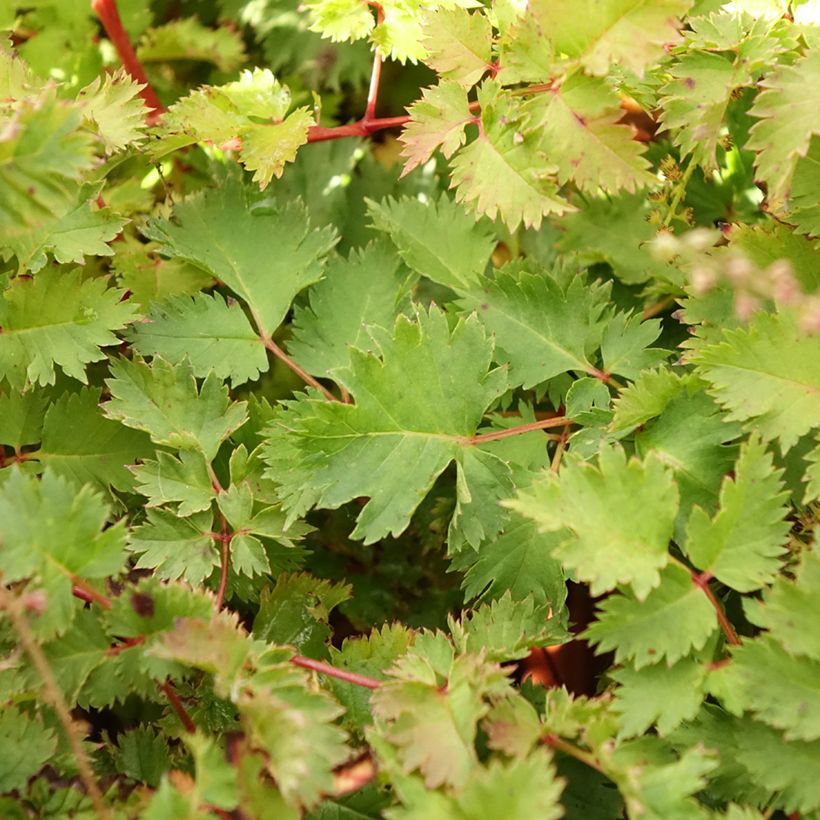

Flowering
Foliage
Plant habit
Botanical data
Aruncus
aethusifolius x dioicus
Chantilly Lace
Rosaceae
Goat's Beard
Cultivar or hybrid
Other Aruncus
Planting and care
To grow the 'Chantilly Lace' hybrid Aruncus, plant it in an area with full sun or partial shade, depending on the soil's freshness. The plant needs moist to damp soil rich in humus and has a neutral to acidic pH. If your soil is clay, amend it to ensure it's healthy. Plant it in partial shade or a sunny spot that's not too hot, as these plants grow in damp woodlands. During hot summers, water the plant daily. It's best to plant it in a sheltered spot away from strong winds. After the flowering period, prune the faded flowers to promote better foliage growth. Alternatively, the flower stalks can be left in place to decorate the garden in winter and removed in spring. Avoid working the soil near these plants, as the rootstocks develop on the surface. These plants are disease-resistant and rarely attacked by insects.
Planting period
Intended location
Care
-
, onOrder confirmed
Reply from on Promesse de fleurs
Summer flowering perennials
Haven't found what you were looking for?
Hardiness is the lowest winter temperature a plant can endure without suffering serious damage or even dying. However, hardiness is affected by location (a sheltered area, such as a patio), protection (winter cover) and soil type (hardiness is improved by well-drained soil).

Photo Sharing Terms & Conditions
In order to encourage gardeners to interact and share their experiences, Promesse de fleurs offers various media enabling content to be uploaded onto its Site - in particular via the ‘Photo sharing’ module.
The User agrees to refrain from:
- Posting any content that is illegal, prejudicial, insulting, racist, inciteful to hatred, revisionist, contrary to public decency, that infringes on privacy or on the privacy rights of third parties, in particular the publicity rights of persons and goods, intellectual property rights, or the right to privacy.
- Submitting content on behalf of a third party;
- Impersonate the identity of a third party and/or publish any personal information about a third party;
In general, the User undertakes to refrain from any unethical behaviour.
All Content (in particular text, comments, files, images, photos, videos, creative works, etc.), which may be subject to property or intellectual property rights, image or other private rights, shall remain the property of the User, subject to the limited rights granted by the terms of the licence granted by Promesse de fleurs as stated below. Users are at liberty to publish or not to publish such Content on the Site, notably via the ‘Photo Sharing’ facility, and accept that this Content shall be made public and freely accessible, notably on the Internet.
Users further acknowledge, undertake to have ,and guarantee that they hold all necessary rights and permissions to publish such material on the Site, in particular with regard to the legislation in force pertaining to any privacy, property, intellectual property, image, or contractual rights, or rights of any other nature. By publishing such Content on the Site, Users acknowledge accepting full liability as publishers of the Content within the meaning of the law, and grant Promesse de fleurs, free of charge, an inclusive, worldwide licence for the said Content for the entire duration of its publication, including all reproduction, representation, up/downloading, displaying, performing, transmission, and storage rights.
Users also grant permission for their name to be linked to the Content and accept that this link may not always be made available.
By engaging in posting material, Users consent to their Content becoming automatically accessible on the Internet, in particular on other sites and/or blogs and/or web pages of the Promesse de fleurs site, including in particular social pages and the Promesse de fleurs catalogue.
Users may secure the removal of entrusted content free of charge by issuing a simple request via our contact form.
The flowering period indicated on our website applies to countries and regions located in USDA zone 8 (France, the United Kingdom, Ireland, the Netherlands, etc.)
It will vary according to where you live:
- In zones 9 to 10 (Italy, Spain, Greece, etc.), flowering will occur about 2 to 4 weeks earlier.
- In zones 6 to 7 (Germany, Poland, Slovenia, and lower mountainous regions), flowering will be delayed by 2 to 3 weeks.
- In zone 5 (Central Europe, Scandinavia), blooming will be delayed by 3 to 5 weeks.
In temperate climates, pruning of spring-flowering shrubs (forsythia, spireas, etc.) should be done just after flowering.
Pruning of summer-flowering shrubs (Indian Lilac, Perovskia, etc.) can be done in winter or spring.
In cold regions as well as with frost-sensitive plants, avoid pruning too early when severe frosts may still occur.
The planting period indicated on our website applies to countries and regions located in USDA zone 8 (France, United Kingdom, Ireland, Netherlands).
It will vary according to where you live:
- In Mediterranean zones (Marseille, Madrid, Milan, etc.), autumn and winter are the best planting periods.
- In continental zones (Strasbourg, Munich, Vienna, etc.), delay planting by 2 to 3 weeks in spring and bring it forward by 2 to 4 weeks in autumn.
- In mountainous regions (the Alps, Pyrenees, Carpathians, etc.), it is best to plant in late spring (May-June) or late summer (August-September).
The harvesting period indicated on our website applies to countries and regions in USDA zone 8 (France, England, Ireland, the Netherlands).
In colder areas (Scandinavia, Poland, Austria...) fruit and vegetable harvests are likely to be delayed by 3-4 weeks.
In warmer areas (Italy, Spain, Greece, etc.), harvesting will probably take place earlier, depending on weather conditions.
The sowing periods indicated on our website apply to countries and regions within USDA Zone 8 (France, UK, Ireland, Netherlands).
In colder areas (Scandinavia, Poland, Austria...), delay any outdoor sowing by 3-4 weeks, or sow under glass.
In warmer climes (Italy, Spain, Greece, etc.), bring outdoor sowing forward by a few weeks.

































